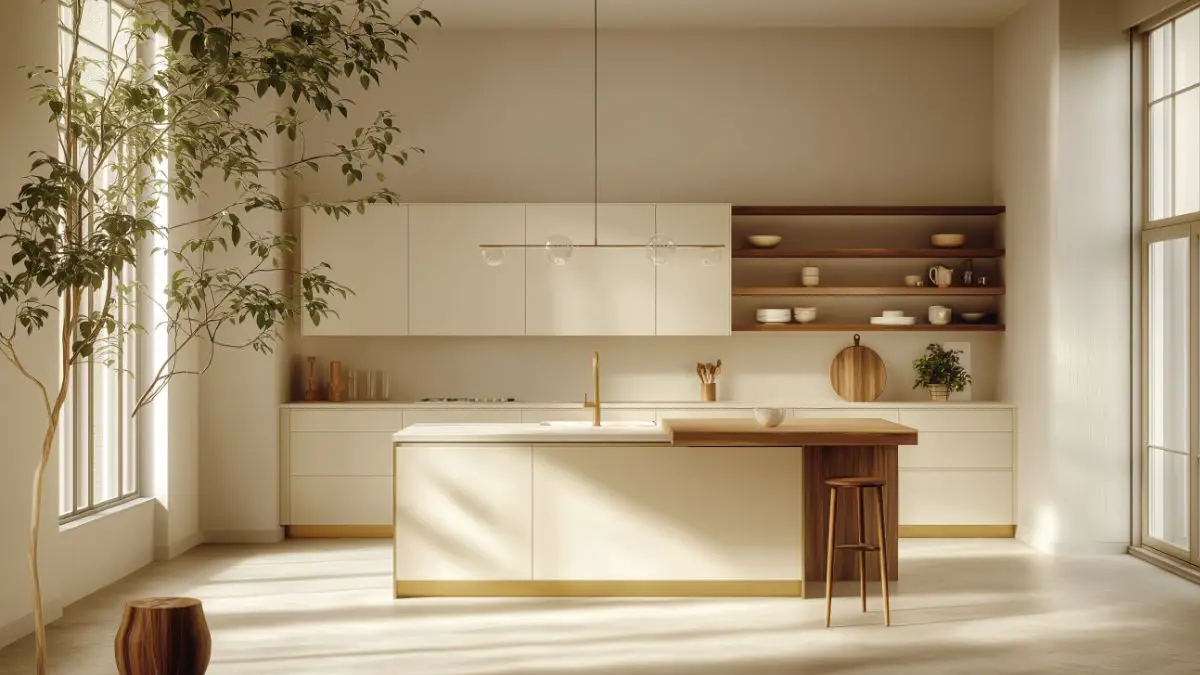How to Design a Warm White Kitchen with Natural Wood Accents for Timeless Appeal
Table of Contents
Introduction
A white kitchen will always be in style—but today’s design-savvy homeowners are leaning into warmer whites and organic textures to create spaces that feel less sterile and more soulful. In fact, according to the 2024 Houzz Kitchen Trends Study, over 70% of kitchen remodels now incorporate warm neutrals and natural wood—a response to the growing desire for homes that feel grounded, welcoming, and timeless.
So how do you design a white kitchen that doesn’t feel cold or overly modern? The answer lies in the intentional layering of materials, tones, and wood elements. From cabinetry and countertops to hardware and lighting, every detail counts.
In this guide, we’ll break down how to thoughtfully design a warm white kitchen with natural wood accents—covering layout, finishes, color pairing, and styling techniques that create cohesion and comfort. Whether you’re building from scratch or simply refreshing your current kitchen, these ideas will help you strike the perfect balance between brightness and warmth.
In-Depth Outline
1. Choosing the Right Shade of Warm White
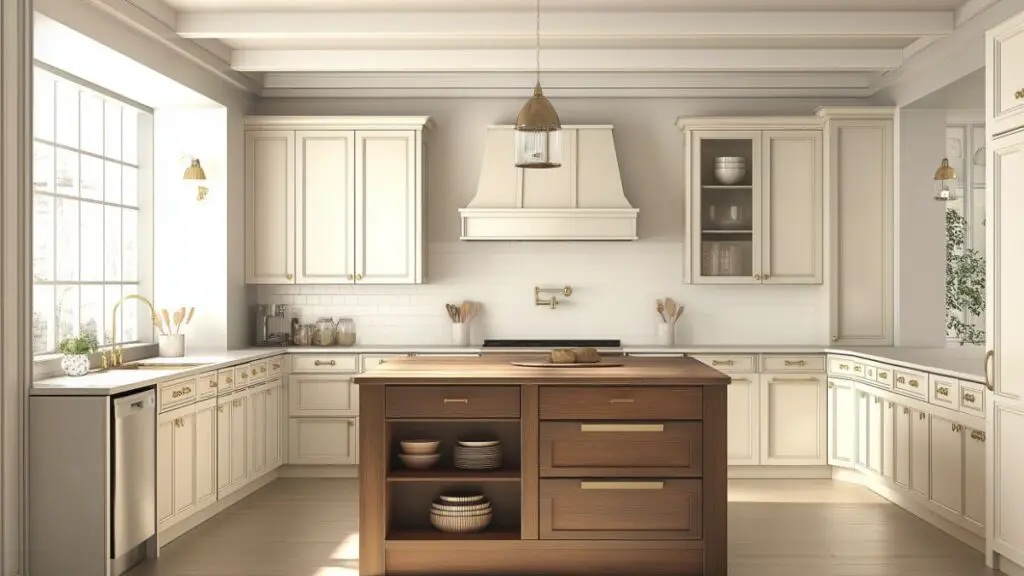
- Avoid stark “builder-grade” whites—look for creams, off-whites, or soft greige.
- Consider undertones (yellow, pink, or taupe) based on your flooring and lighting.
- Test paint colors in natural and artificial light at different times of day.
- Top warm whites: Sherwin-Williams Alabaster, Benjamin Moore White Dove.
- Matte and satin finishes enhance softness and reduce glare.
Table: Popular Warm White Paint Options
| Brand | Color Name | Undertone |
|---|---|---|
| Sherwin-Williams | Alabaster | Creamy, soft yellow |
| Benjamin Moore | White Dove | Warm greige |
| Farrow & Ball | Pointing | Slight pink tone |
2. How to Integrate Natural Wood Accents Seamlessly
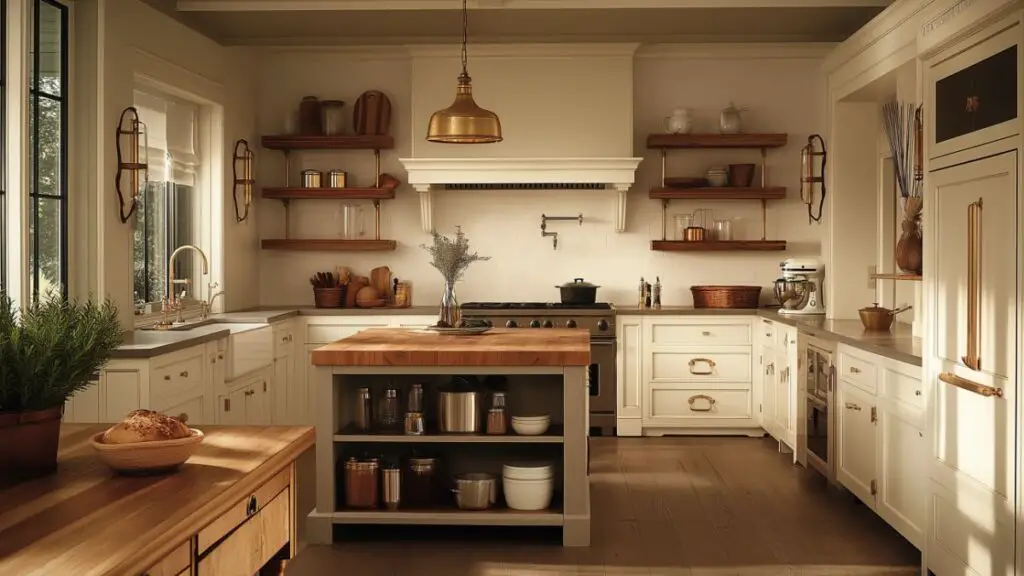
- Use white oak or walnut for islands, open shelves, or vent hoods.
- Mix wood tones with intention—light woods with white for a Scandinavian look, darker for contrast.
- Matte or raw finishes feel more organic and less rustic than varnished wood.
- Use consistent grain direction to keep the look refined.
- Wood drawer pulls or floating shelves add subtle dimension.
Table: Natural Wood Applications in Kitchens
| Feature | Best Wood Type | Design Tip |
|---|---|---|
| Island Base | White oak, birch | Pair with white quartz countertop |
| Floating Shelves | Walnut, pine | Style with ceramics + greenery |
| Hood Cover | White oak, ash | Match to flooring or island wood |
3. Best Countertops for a Warm White and Wood Palette
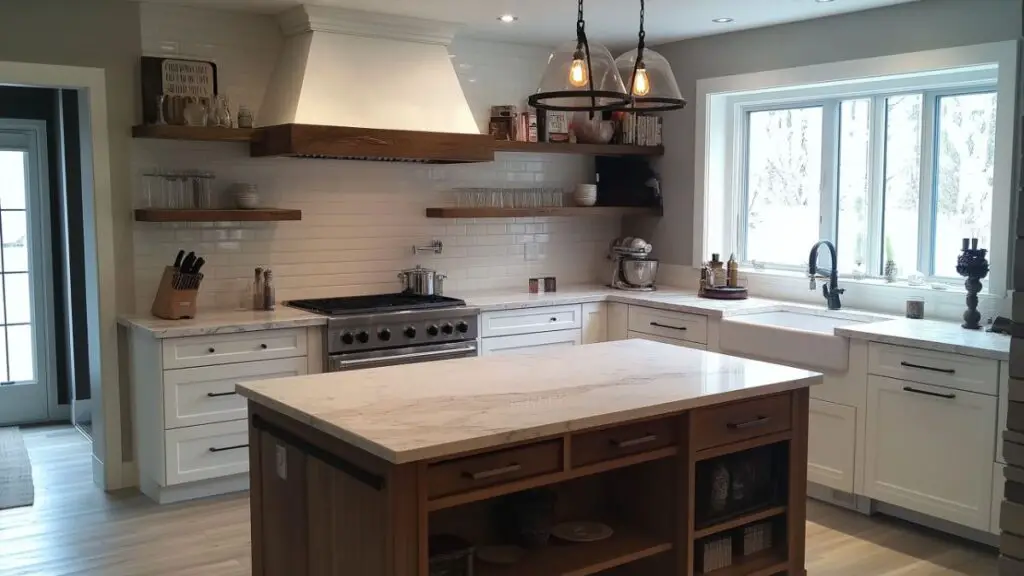
- Go with creamy quartz or honed marble for softness.
- Butcher block pairs beautifully with wood accents but needs maintenance.
- Avoid icy white counters—opt for ones with warm veining or taupe flecks.
- Waterfall edges in wood tone create visual continuation.
Table: Countertop Materials Comparison
| Material | Warmth Level | Maintenance | Works With Wood? |
|---|---|---|---|
| Quartz (warm) | ★★★★★ | Low | Yes |
| Butcher Block | ★★★★☆ | Moderate | Seamless |
| Marble (honed) | ★★★★☆ | High | Elegant pairing |
4. Choosing Hardware and Fixtures That Complement Warm Tones
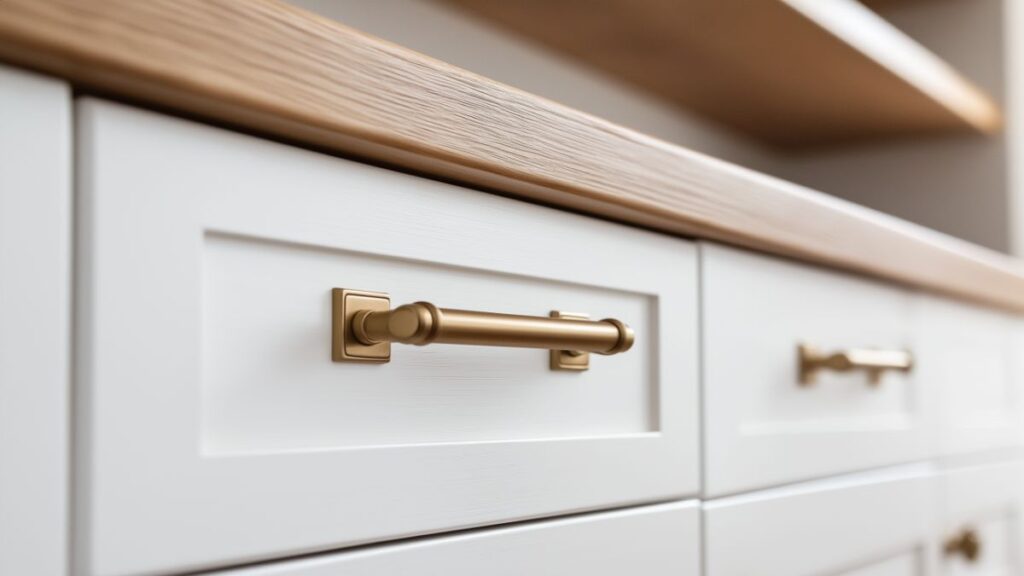
- Brass, matte black, or antique bronze work beautifully with wood.
- Avoid shiny chrome, which feels too cold in warm-toned spaces.
- Use matching tones across cabinet pulls, faucets, and lighting for cohesion.
- Soft arch or vintage-style handles pair well with shaker or flat-panel cabinetry.
Table: Hardware Finishes & Pairings
| Finish | Best Cabinet Color Pairing | Adds Warmth? |
|---|---|---|
| Aged Brass | Alabaster, cream | ✅ |
| Matte Black | Greige, off-white | ✅ |
| Brushed Nickel | Cooler whites only | ❌ |
5. Backsplash Ideas That Add Warmth Without Clashing

- Zellige or handmade tiles reflect light softly and add texture.
- Creamy subway tile offers subtle contrast against white walls.
- Terracotta or clay tiles bring in warmth and rustic charm.
- Try vertical stack for a modern twist on traditional tile.
Table: Backsplash Tile Options for Warm Kitchens
| Tile Style | Texture Level | Warmth Factor | Recommended Use |
|---|---|---|---|
| Zellige (glossy) | High | ★★★★★ | Behind stove or sink |
| Handmade subway | Medium | ★★★★☆ | Full wall or half splash |
| Terracotta/clay | Low–Medium | ★★★★★ | Accent only |
6. Lighting Techniques to Enhance Warmth
- Use layered lighting: ambient, task, and accent.
- Install warm-toned bulbs (2700K–3000K).
- Add pendant lights with fabric, rattan, or aged metal finishes.
- Under-cabinet lighting creates cozy ambiance in the evening.
Table: Kitchen Lighting Layers
| Lighting Type | Fixture Ideas | Function |
|---|---|---|
| Ambient | Flush-mount or recessed LEDs | General illumination |
| Task | Pendant over island | Focused prep lighting |
| Accent | Undercabinet or sconces | Visual warmth |
7. Styling Tips: Finishing Touches That Tie It Together
- Use neutral ceramic canisters, linen textiles, and greenery for color.
- Open wood shelving is ideal for hand-thrown pottery or vintage glassware.
- Add a warm-toned rug for softness underfoot and visual warmth.
- Style countertops minimally—3–5 curated objects max.
Table: Kitchen Styling Accessories
| Item | Material/Color | Effect on Space |
|---|---|---|
| Countertop décor | Wood, white ceramic, brass | Adds texture & depth |
| Kitchen rug | Terracotta, beige, rust | Visual anchor, softness |
| Wall art or prints | Botanical or minimal sketch | Personal warmth |
Detailed Content Expansion
1. Choosing the Right Shade of Warm White
Selecting the right shade of white can make or break your kitchen’s atmosphere. A crisp, cool white may feel fresh, but it often reads sterile—especially when paired with wood, which thrives in a warm and welcoming environment. Instead, lean into whites that have creamy, greige, or soft beige undertones.
Some designer favorites include Sherwin-Williams Alabaster for its soft yellow warmth, or Benjamin Moore White Dove, which leans more toward greige. If you prefer a chalky, European-style look, Farrow & Ball Pointing adds subtle depth with pink undertones.
To avoid surprises, test your paint in morning and evening light, and observe how it plays off countertops, wood tones, and natural lighting. Warmer whites tend to work well in northern light, which can cast cooler blue tones into your space.
Table: Popular Warm White Paint Options
| Brand | Color Name | Undertone |
|---|---|---|
| Sherwin-Williams | Alabaster | Creamy yellow |
| Benjamin Moore | White Dove | Soft greige |
| Farrow & Ball | Pointing | Subtle pink warmth |
2. How to Integrate Natural Wood Accents Seamlessly
Natural wood accents are the key to balancing a bright white kitchen with depth and comfort. The goal is to use wood intentionally—never randomly—so it feels like a curated part of the design, not an afterthought.
Start with your focal point: a white oak island, for example, grounds the space and instantly introduces warmth. If you’re going for contrast, walnut or stained birch provides rich tones that elevate visual interest. From there, build in accents like floating shelves, a matching vent hood, or cabinet trim.
To keep the look modern and cohesive, stick with matte or natural finishes, and avoid overly glossy woods that can clash with soft whites. If mixing wood tones, keep one consistent across dominant features (e.g., floors and shelves) while adding variation in smaller doses (e.g., bar stools or cutting boards).
Table: Natural Wood Applications in Kitchens
| Feature | Best Wood Type | Design Tip |
|---|---|---|
| Island Base | White oak, birch | Pair with quartz or marble top |
| Floating Shelves | Walnut, pine | Style with neutral ceramics |
| Hood Cover | White oak, ash | Align stain with flooring |
Conclusion
Designing a warm white kitchen with natural wood accents is all about creating balance: bright, open spaces softened by organic texture and thoughtful layering. With the right paint shade, materials, and details—from countertop choices to under-cabinet lighting—you can build a space that feels both modern and timeless. For a home decor lover, it’s the ultimate blend of clean design and inviting charm—a kitchen that works just as beautifully for everyday life as it does for entertaining.

